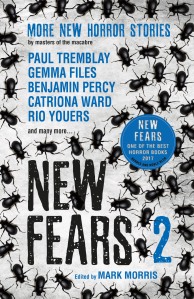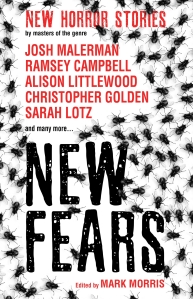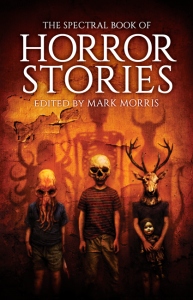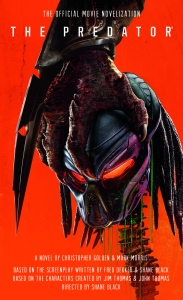Interview: Mark Morris (New Fears 2)
Mark Morris’ second collection of horror stories for Titan, New Fears 2, came out at the end of September and is once again an eclectic mix of very many different […]
Mark Morris’ second collection of horror stories for Titan, New Fears 2, came out at the end of September and is once again an eclectic mix of very many different […]
 Mark Morris’ second collection of horror stories for Titan, New Fears 2, came out at the end of September and is once again an eclectic mix of very many different types of horror story. Prior to working on these, Morris edited two volumes of The Spectral Book of Horror Stories (read our interview with him about those here), and recently answered some questions from Paul Simpson about his quartet of terror…
Mark Morris’ second collection of horror stories for Titan, New Fears 2, came out at the end of September and is once again an eclectic mix of very many different types of horror story. Prior to working on these, Morris edited two volumes of The Spectral Book of Horror Stories (read our interview with him about those here), and recently answered some questions from Paul Simpson about his quartet of terror…This is your fourth collection of horror stories – do you think you’ve even scratched the surface of the potential out there?
Not at all. I could easily fill up at least half a dozen volumes, if not more, of New Fears with writers whose work I’d love to publish, and have an entirely new line-up each time. And every year I’m finding more to add to the list. This year alone I’ve read and loved books by genre writers who are new to me – Jac Jemc, Nick Setchfield, Gary Kemble, C.J. Tudor, Laura Purcell and others.
Has editing the collections become easier over time, or does each volume present new challenges?
I wouldn’t say it’s become easier or more difficult, though I did streamline the process for volume two. With volume one, although I sent out specific invitations to various writers, I announced an open submissions policy from the start, and ended up getting swamped with submissions. For volume two I sent invitations to maybe 25-30 writers, knowing that some of them wouldn’t have time to write me anything, or, for whatever reason, wouldn’t ultimately deliver, and then, a few months from the deadline, announced an open submissions window that was only a month long. The aim was to end up with an anthology comprised of 80% commissions and 20% submissions, and on the whole I’d say that worked out pretty well.
 Were any holdovers from New Fears 1 or other projects?
Were any holdovers from New Fears 1 or other projects?
No, there were no holdovers – all the stories in New Fears 2 were specifically selected for that anthology. Also my aim with New Fears 2 was to have a completely new line-up to the original volume, so anyone who had a story in that was prohibited from sending me anything for the second volume. I know in the past some editors have used their favourite writers for volume after volume of an anthology series, but there is so much talent out there, and so few anthology slots available, that I wanted to give as many writers as possible a chance to contribute.
Did you continue to give no particular parameters for the stories? They’re all varying lengths and styles, so was there any particular restriction every story had to abide by?
No, no parameters. All styles, subjects and lengths were considered. Perhaps my only word of caution was to let potential contributors know that I had to bring the book in at around 100,000 words, so if someone were to deliver, say, a 20,000 word story, it would pretty much have to be the best 20,000 word story I’d ever read to have a realistic chance of getting in. I consolidated this by stipulating that although I was paying a decent word-rate, it had a ceiling of 5,000 words. Anyone delivering a story over 5,000 words would effectively, therefore, be giving me those extra words for free.
 Has the nature of horror stories changed during the period you’ve been editing collections, in terms of the sorts of stories people are sending you?
Has the nature of horror stories changed during the period you’ve been editing collections, in terms of the sorts of stories people are sending you?
To be honest, you still get more than your fair share of bog-standard vampire/ Halloween/revenge stories, but what I’ve found is that in the top two or three per cent of stories – i.e. those stories that have a realistic chance of actually making the anthology – you’ll get a huge amount of invention and experimentation; you’ll get writers pushing at the very edges of the genre, and producing stories that are so audacious and strange and unique that they often make you question whether what you’re reading is actually a horror story at all.
Don’t get me wrong – some of the stories in New Fears are very recognisably horror stories. But there are others that, in my opinion, are horror stories only because they give you the same feelings that well-told but ‘conventional’ horror stories do – which is that they unsettle you and disturb you, and make you feel that reality is shifting, that you’re not in control, that the rug has been pulled out from under your feet. We go through life with this illusion that we’re running the show, and a really good horror story should undermine that and make you think about things more deeply, and perhaps in some way prepare you for the bad stuff – if, indeed, you can be prepared for it, which is highly debatable.
Have any of the stories you’ve edited actually given you goosebumps or nightmares?
Not nightmares so much, but goosebumps certainly – or, more commonly, moments when you feel a sense of ‘otherness’, or cosmic awe, or when you genuinely feel as though you’ve just been given a glimpse through some very dark doorways that perhaps should have remained shut.
One of the delights of reading and reviewing these collections is finding authors whose work you then want to delve into more – has that happened to you too?
Absolutely. Over the years I’ve discovered many, many writers through first encountering their work in anthologies, which is why contributor biographies are so important. As for the anthologies I’ve actually edited myself, I’d never heard of Kurt Fawver until he sent me his story ‘Marrowvale’, which blew me away and which I accepted for The 2nd Spectral Book of Horror Stories – and which was subsequently reprinted by Steve Jones in Best New Horror 27. It’s because of ‘Marrowvale’ that I recently ordered Kurt’s collection ‘The Dissolution of Small Worlds’, which I can’t wait to read.
 The same day as New Fears 2 came out, your novelisation of The Predator hit the shops – co-written with Christopher Golden; how did the pair of you divide the writing on that?
The same day as New Fears 2 came out, your novelisation of The Predator hit the shops – co-written with Christopher Golden; how did the pair of you divide the writing on that?
Chris was originally contracted to write the book single-handedly, and had actually written and delivered a full novelisation based on an early version of the script when the production company sent him a second, heavily-amended script and asked him to re-write his novelisation accordingly. However the changes were so extensive that it would have meant scrapping and re-writing around 50% of the book, and as Chris was then engaged in another project with a tight deadline, our mutual agent, at Chris’s request, asked for (and was given) more money from the publisher to bring me on board.
I literally had Chris’s original novelisation and the new script side by side, and had to compare and contrast them, making copious notes along the way. Once that was done, I started the rewrite, which involved lightly editing some bits of Chris’s book, heavily editing other bits, and completely scrapping other bits and writing brand new scenes in their place. Luckily Chris and I have a similar approach and style when it comes to writing novelisations. Though I say it myself, I think we’re both pretty good at writing ‘slick’ prose – i.e. prose which is clear, clean, fast-moving and readable (a skill I learned from reading and re-reading hundreds of Terrance Dicks’ Doctor Who novelisations as a kid). As a result, I think the novelisation of The Predator, although it was something of a rush job, reads well and is pretty seamless. I’m pretty sure anyone reading it would be hard-pressed to tell which bits were Chris’s and which were mine.
Apart from promoting New Fears, what are you currently working on?
I’m just about to start a novella for PS, which is part of a project conceived, developed and pitched by myself and four other writer friends – Chris Golden (again), Tim Lebbon, Stephen Volk and Stephen Bissette – and which I probably shouldn’t say any more about at the moment. Sticking with PS, I have a couple of new stories to write for a career overview Best Of… short story collection, which PS will be publishing next year to celebrate my thirtieth anniversary as a professional writer. I’ve just finished another audio drama, which I’m excited about, but again which I’m not allowed to elaborate on at present. And aside from that I’m working on a new novel proposal, a collaborative YA novel with Tim Lebbon, which we’ve been writing on and off in our (very limited) spare time for the past ten years or so now, and I’m also due to write a monograph about the movie Sinister at some point for Neil Snowdon’s Electric Dreamhouse imprint.
New Fears 2 is available from Titan Books now